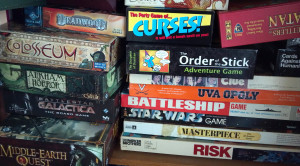Naming a board or card game can be a tricky thing – one I had not remotely experienced until time came to finalize my 60’s summer vacation game’s name. Though I eventually settled on Roadtrip!, the agonizing process brought about a good deal of reflection on the subject. Not that I expect a name alone would determine success; after all, in today’s golden crowded marketspace, a lot more goes into success than just a name. Still, a name has impact. A good one may even give that indefinable, extra mnemonic boost. So, how do you name a board game?
Now you can find all sorts of heady articles (and some books) about naming video games; some of their instruction I found to apply. But though there is overlap in audience, not all of their advice seemed to apply equally. Further, the books that I found on designing board games, didn’t really address the subject directly. Brian Tinsman, in The Game Inventor’s Guidebook, speaking more generally, says that a game needs a ‘hook’, “… a concept that grabs people and makes them want to pick up the box.” Absolutely! But still, what about a name? I just wanted some basic rules about which to approach naming that didn’t solely involve brainstorming on little pieces of paper for a few months. I needed broader guidelines, something that would help guide that brainstorming a bit.

After some frustration, I decided to look at the problem from a different perspective. Instead of looking for guidance in the form of ready-made rules, I looked in my own games closet. Why did I buy these games? Then I looked up the top-rated and most-rated games on Board Game Geek. I added to that list Games Magazine’s top-rated games from 2014. What do all of these game names have in common? From patterns I found in those lists, I sketched the following guidelines. Please note that I am not (in any way) an expert. My background does not include a degree in game design nor formal study in marketing. But, for what it’s worth, here are my observations:
Make a simple name. Believe it or not, most successful board games consist of one noun or a single noun-adjective phrase.
- Keep it 4 syllables or less. Most people will shorten the name anyway, so it might as well already be short. If it’s longer, like The Castles of Burgundy, know that it’ll likely become ‘Burgundy’. If that’s still fits your design, then you are good.
- Tie-in the central theme or mechanic. The name or its shortened nickname should contain something recognizable to the people at whom your game is targeted. Terra Mystica infers a fantasy realm; Caverna invokes images of caves; Through the Ages implies a game of epochs. If you have an invented, largely unrecognizable, or ambiguous name, realize that unless you provide further context (see subtitles and cover art below), the game will not immediately mean anything to people. If that name is viewed only briefly on the side of its box (like many games stacked in game stores or libraries), smaller cover art may not be enough to overcome misconception from an enthusiast.
- Be clever, but not too clever. Agricola is the Latin name for farmer; Caverna is the Italian name for cave; Carcassonne is the name of a wonderfully-preserved, fortified, medieval French town. Use alliteration (similar sounding words) or portmanteaus (combining pieces from two different words), or other literary devices only if they make sense. Notice that none of the top games on BGG’s lists use these concepts.
Use a subtitle. Subtitles are useful for more than just expansions. Not every game has to have a subtitle. And, quite frankly, some designers do not like subtitles. However, a subtitle is extremely useful in honing expectations of gameplay. Twilight Struggle without its subtitle ‘The Cold War’ leaves a lot open to imagination. Tzolk’in without ‘The Mayan Calendar’ most likely means nothing to potential buyers.
- Keep it 10 syllables or less. Just describe your game in a few fun words. Period. It does not have to be syntactically complete or even grammatically correct. It has to be interesting enough to get someone to pause and reach for the box, but short enough not to seem tedious. Don’t rephrase the game name, expand upon it.
- Be clever. Here is where you can afford more cleverness. Use alliteration (Morels: Foraging and Feasting for Two). Use bold action words (Catan: Trade, Build, Settle). Use appropriate slang, period terminology, or portmanteaus (Android: Netrunner).
- Look it up. Names mean different things to different people. So, look up the name, its possible nickname(s), and the subtitle language. Online sources like Google, Wikipedia, and Urban Dictionary are quick and fruitful. At the very least, you might discover your clever name is already in use by a lesser-known kitchen cleanser that fell into obscurity after several unfortunate chemical accidents. At the most, you might find new ways to tweak your design, its name and subtitle to appeal to a wider audience more immediately.
Use quality cover art. No one ever buys anything today without seeing it first. The single exception may be word-of-mouth. But somewhere there, someone saw it before they bought it. In board game terms, this means that your board game will be inextricably linked to its cover art and logo… for good and bad… forever. Use that art to convey the full experience of the game.
- Pay a professional artist. If you are not a real artist, pay someone to enact your vision. Odds are that you will need one anyway for other aspects of your game. You might even have one already. Regardless, the cover art and name (in a suitable font) is the first impression anyone will have of your game. Terra Mystica has a dwarf with a shovel heading off into an unexplored land with pristine mountains. Puerto Rico shows a merchant ship, laden with goods, in a wealthy harbor. What the name can’t convey, the art must. Truly, you need cover art before you need illustrations on each card or player mat. What do those matter, after all, if no one picks up the box?
- Consider a tagline. A tagline is a brief, syntactically-sound summary. To some extent, a subtitle and a tagline overlap in purpose. However, I think of the difference as explanational versus experiential. For board games, where outcomes vary from one play to the next, a question can be more appropriate. Take Pandemic, for example. The subtitle, ‘A New Challenge’, refines expectations about the type epidemic that players are battling. Whereas, the tagline, ‘Can you save humanity?’, elicits an emotional response and a call to action.
- Use the 8-second rule. A recent study showed that in 2015 the average attention span is 8.25 seconds. That is down from the 12 seconds in 2000. This downward trend is important if you expect people to pick your game off of a shelf full of games or out of an internet crammed with thousands of alternate options. Your game name and the cover art, plus any subtitle and tagline, will only ever get 8 seconds of attention. In that time it must compellingly convey the game experience. Cluttered art, names that are too long or too complicated, a lengthy subtitle, or verbose tagline will repel buyers.
Again, let me reiterate that a name alone will not sell your game for you. Only you and a ton of hustle (and/or a lot of help) can do that. However, a good game name coupled to a descriptive subtitle or fun tagline and quality cover art can make your work easier. You want the name to work for you, not against you.
Let me know what you think! Have you had trouble naming a game before? How have you solved it? Can you add to these tips?
